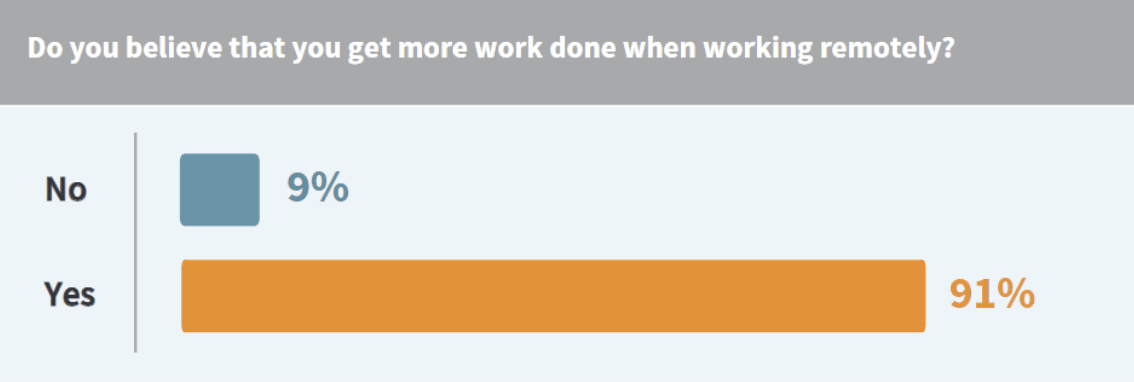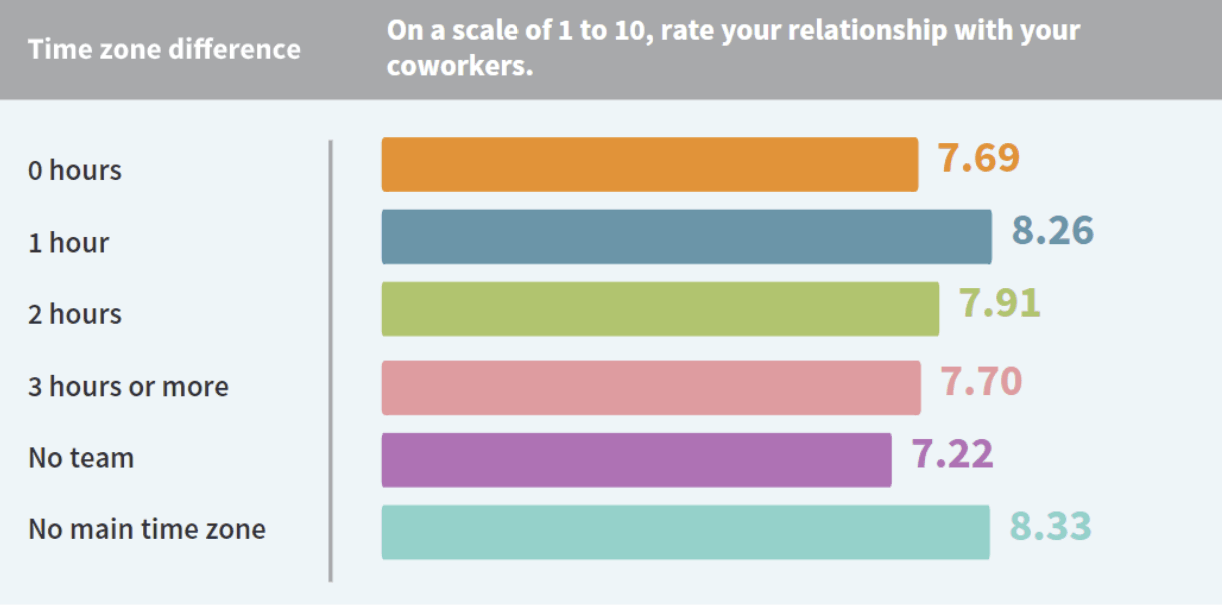As the remote working trend continues to grow at a mind-boggling pace, some surprising remote work statistics emerge every year.
One a luxury of the past, 2019 remote working statistics show that working from home (at least some of the time) is rapidly becoming an accepted norm.
As the remote working trend grows, more money is being spent on research to discover what its effects – good and bad – truly are.
Read on for some surprising statistics on the state of remote work.
What Do Remote Work Statistics Tell Us About Demographics?
You might have guessed that most remote workers are young, tech-savvy introverts in lower positions on the corporate ladder.
[demo]
Not quite. A survey conducted by TalentLMS found that as many as 34% of remote workers consider themselves extroverts. Introverts were the minority at 28%, while 38% identify as ambiverts.
The Boss Is More Likely to Work Remotely
In the past, remote work was often the domain of more menial positions – for example, customer service positions that relied on phone calls. Remote work statistics indicate this has changed.
Managers and leaders (12%) are now twice as likely to work remotely compared to individual contributors. On the other hand, these individual contributors do spend more time teleworking.
As artificial intelligence becomes more pervasive, it’s possible that these individual contributors can spend more time working remotely. Being on-site should become less important as A.I. becomes better suited to handle certain tasks.
Surprising Remote Work Statistics Related to Gender
There are also some interesting differences between traditional genders as remote workers. For example, men are 8% more likely to work remotely than women are.
This could be startling to some since remote work can offer massive advantages for mothers. For example, in the tech industry, 56% of women leave their job mid-career. Motherhood is hard, with 51% of women citing that it throws a wrench in the gear of their career advancement.
Traditional genders also differ in why they prefer remote work. For example, more men than women prefer remote work to save money, have better focus, and be more productive.
There’s also a wage gap. The number of remote male workers earning under $25,000 is less than half of the number of female workers in the equivalent wage bracket. Meanwhile, the majority of remote workers earning less than $50,000 are female.

In the past, this could have been explained by mothers working part-time in lower-paying positions. However, as higher-paid workers leave the office for home, it’s possible that this gender salary difference will shrink.
No Matter Your Age, Chances Are That You Want to Work Remotely
If you guessed that remote workers tend to be younger, you’d be right (soon).
By 2020, 36% of the remote workforce will be Gen Z. This generation – which grew up with digital tools as a part of their daily lives – seems more inclined to pursue nontraditional office and corporate roles.
On the other end of the age continuum, we still see a strong desire for remote work. For example, in America, the number of employees over the age of 64 continues to grow. According to a poll by AARP, 74% of older Americans wanted flexible schedules ad 34% preferred to work from home.
Remote work statistics tell us that almost all millennials prefer to telecommute. Telecommuting part-time is tolerable for 50%, but FlexJobs survey found that 85% of millennials wanted to work from home 100% of the time. This is eerily close to the 84% who preferred a better work/life balance.
Employers Take Notice: Flexible Schedules Increase Job Satisfaction
Offering remote work opportunities might be a requirement for many businesses soon if they want to keep their employees.
Gartner found that employee retention rates increase by 10% if the business allows remote working, and Stanford found that employee turnover dropped by half when organizations offered remote work opportunities.
FlexJobs found that 32% of workers have left a job because it didn’t offer enough flexibility. Even more employees might be on the fence, with 79% saying they would be more loyal to a business if it offered for flexibility.

Remote Work Statistics Indicate Significant Financial Benefits for Both Employers and Employees
Remote Work Benefits to Employers: Saving Money
Global Workplace Analytics found that businesses can save up to $11,000 per employee every year – just by allowing them to work from home.
AT&T saved $30 million in real estate by offering remote work options. Similarly, Dell expects to save $12 million on office space expenses as it expands its remote work program.
Employees Essentially Get a Raise
Working from home can act as a salary raise for many employees. Perhaps this is an unstated reason for why so many prefer remote jobs.
Remote work statistics indicate that simply showing up to an office costs employees between $2500 and $6000 dollars a year. This was further confirmed by a CoSo Cloud survey, where employees working from home reported saving up to $5,240 every year.
How Does Remote Work Affect Office Productivity?
Often, a manager’s biggest fear is that remote workers will shirk their work as they lounge in pajamas as a caricature of the remote worker stereotype.
Remote work statistics suggest this isn’t (usually) the case.
Remote Work is Only For the Right Team Members Who Are Skilled in Time Management
Using tests like StrengthFinders to build a remote team increases the odds of productivity. Too many members of a certain personality leave the team deficient in other areas, or prone to miscommunication.
Similarly, remote work might be too much for some employees to handle. Someone with poor time management skills is unlikely to be more productive unless supervised.
Nonetheless, studies are confirming that offering remote work to the right people provides an incredible remote productivity boost.
Employees Say They’re More Productive – and Love It
Very few workers enjoy their commute. Statistics show this is the number two reason for choosing to work remotely.
Surprisingly, work/life balance trails behind as the number three reason. It’s important, but employees seem to value their productivity more.
The primary reason for wanting to work remotely? Increased productivity and better focus.
Statistically, 77% believe they are more productive when working remotely. Working from home supposedly helps 30% of employees get more done in less time.
Is Remote Office Productivity as High as Employees Claim?
Are remote employees just claiming to be more productive to get their work-from-home ticket?

Remote work statistics suggest that employee productivity does actually soar.
As long ago as 2009, Cisco’s Internet Business Services Group reported that their remote employees saved them $277 million in productivity that year.
AT&T offers a similarly mind-boggling remote work statistic. They estimated an extra $150 million of productive time from their employees working from home.
Remote Work Statistics Indicate that Remote Employees Work Longer
Instead of slacking off and working less, remote employees actually seem to work more. Studies from the U.S. News & World Report found that remote workers work 6-7 more hours per week than on-site employees.
One reason for this voluntary extra work could be the reduced commute. For example, in the USA, employees spend up to 11 days a year on the commute alone.
When these hours are added to the workweek, and less commuting stress is factored in, it makes sense that remote workers are willing to work longer.
Why Are Remote Employees Shockingly Productive?
The reasons will vary from person to person – but what do the statistics say?
Is the Remote Worker Productivity Boost From Sleep?
It’s unclear. On average, remote workers do get an extra hour of sleep per week.
Some astonishing statistics indicate that employees who always feel tired are 270% more likely to be absent, and 440% less productive. Add it up, and you get a yearly $411 billion economic loss for the USA and a $138 billion loss for Japan.
On the other hand, a survey of remote workers across 15 countries casts doubt on this statistic. Waking up repeatedly in the night was 13% more common in remote workers – possibly from stress from the lack of separation between office and home.
Even if remote workers are sleeping more, the American Journal of Health Promotion found that employees who sleep 10 or more hours per night miss work 160% more often from illness. They’re also 220% less productive than employees who sleep eight hours every night.
Granted, someone who sleeps more than usual is likely to have a chronic health condition. A productive employee who happens to get more sleep won’t suddenly begin missing work.

Still, these statistics make it unclear whether remote workers are enjoying – and being more productive from – better sleep.
Remote Workers Have Fewer Office Distractions
It’s easier to argue that the productivity boost for remote workers stems from reduced distractions. Offices are noisy. Interruptions interfere with deep work.
Interruptions can exist at home also, but remote work statistics suggest that they are less invasive. Even managers agree, with two-thirds indicating that their remote employees are more productive.
Remote Work Statistics on Employee Training in a Virtual Team
Interestingly, 56% more employees who rate their learning style as “physical” (with objects, simulations, and experiences) are fully remote.
Regardless of learning style, remote workers continue to pursue training. For 70% of them, the training is provided by their company. Another 13% get training for themselves. Overall, 85% of remote employees do their training online.
It’s not enough. More work-related training is desired by 67% of these employees.
What About Employee and Workplace Collaboration during Remote Work?
Now that the “lazy” remote worker myth has been largely dispelled by remote work statistics, a new one is taking its place – lack of collaboration.
Is Workplace Collaboration Technology Underutilized?
The past decade has brought an incredible amount of online working tools that is a great help in managing remote workers. Software like Krisp helps remote workers make better, clearer calls. Cloud sharing and sophisticated online collaboration tools abound.
Shockingly, only 20% of project managers considered tools like Asana, JIRA, and Trello to be “very important”. Even more surprising, only 18% considered video chat services like Zoom and Google Hangouts to be key.
This raises the question of whether project managers are receiving proper training to utilize these tools. Perhaps many aren’t aware of the power of these tools.
This seems odd, since collaboration in remote work is one of the most-cited concerns from most upper management. While remote work statistics suggest that remote workers are more productive, they also suggest that collaboration tools may have untapped potential.
It’s possible that collaboration less important than theorized. Perhaps collaboration is more important at higher management levels but can hinder productivity at lower levels. This is likely to vary by industry and individual.
Millennials appear to value online collaboration more, with 49% supporting the use of social tools. Only 31% of baby boomers saw online collaborative social tools as useful.

Interestingly, 26% more millennials had challenges with these tools than baby boomers. It’s possible that these tools lack more sophisticated features that millennials are accustomed to.
Is Employee Collaboration Suffering When Working Remotely?
MIT employees disagree. In fact, during a remote work pilot, a stunning 93% reported better collaboration.
Nonetheless, remote work statistics on collaboration are mixed. A study of engineers found that they were 20% more likely to collaborate when they shared a physical office.
In fact, these engineers in the same space were more 400% more likely to send emails related to their project, and completed projects 32% faster.
Remote work statistics describing the effects of location on collaboration are contradictory. This might be from differences between jobs in the type of work and personality of the workers.
Are Timezones Killing Remote Workers’ Collaboration?
Having a team spread over the globe might sound like kryptonite to a virtual team’s productivity. What do remote work statistics say?
One study found that remote workers lacking an office with a “main” timezone rated their relationships with coworkers at 8.33/10. This is astonishing when considering that workers with zero or three-hour timezone differences only rated their relationships around 7.7.

It seems that being spread out over timezones is (counter-intuitively) more of a benefit than a drawback to employee collaboration.
Is the Work/Life Balance of Remote Work as Good as it Sounds?
One of the most common reasons reported by employees seeking remote work is an improved work/life balance.
Working remotely can be a double-edged sword for work/life balance. On the one hand, employees in some countries save up to 11 days a year by avoiding their commute.
On the other hand, 16% more mobile workers felt constant stress than their office counterparts. When your home is your office, it can be difficult to detach from work. For those remote jobs where collaboration suffers, waiting on colleagues for communication can also be stressful.
Some 41% of highly mobile workers felt stress “always or most of the time” compared to only 25% who always worked at the office.
What About Remote Employee Happiness?
Despite questionable benefits from work/life balance, employees with a flexible work schedule and flexible working hours do seem to be happier.
Full-time teleworkers reported 12% less stress than their colleagues in the office. However, it’s worth noting that part-time teleworkers were just as stressed than traditional workers. If you’re planning to work remotely for less stress, shoot for full-time.
Being isolated seems to have a learning curve. Telecommuters with 6-10 years of experience were 11% happier than those just starting remote work. If you’re feeling lonely as a remote worker – give it time.

Still, 25% of full-time remote workers leave their T.V. on to stave off loneliness.
Surprising Remote Work Statistics by Countries and States
While remote work is a global phenomenon, it does has significant differences around the world.
For example, a study by OWLLabs found that there are 81% more fully remote companies in South America than the rest of the world. Unsurprisingly, South Americans work remotely 67% more than the rest of the world.
At the same time, South America and Asia both have 9% more companies that don’t allow any remote work than the global average.
When hybrid companies are thrown in the mix, Australia (60%) and Africa (59%) emerge as the leaders. Remote workers in Africa do it for better focus, productivity, and to save money; while North Americans work remotely to dodge their commute.
If you’re hunting for a remote job in the USA, which states should you focus on? Remote work statistics published by FlexJobs say that your best bet is to look in New York, Texas, and California. If those aren’t options for you, take a look in Minnesota, North Caroline, and Massachusetts.
Current and Future Work Statistics on a Macro-level
Overall, remote work trends suggest that it’s here to stay and on the rise.
Since 2005, there has been a 140% increase in the remote workforce. Workers are telecommuting 115% more in the USA than they were ten years ago.
A Swiss company found that 53% of employees work remotely for at least half of the week. An additional 17% commute at least one day a week.

Those numbers are just employees! They don’t include the number of rapidly growing freelancers – for example, graphic designers and copywriters. In fact, by 2027, freelancers are expected to be the majority of the workforce in the USA.
Some companies (44%) continue to hold out against the remote work trend – often because the industry doesn’t support it (it’s difficult to be a remote plumber).
Other companies (40%) are hybrid. In favorable industries, 16% have fully taken the plunge and gone fully remote.
What do You Think of Remote Work?
Do you work remotely? Do these statistics reflect what you’ve seen? Why or why not? Leave us a comment telling us about your experience.
Regardless, if you think remote work is a passing fad, the evidence suggests otherwise.
Remote working will rival traditional offices by 2025, according to a mind-boggling remote work statistic published by BlueFace!


